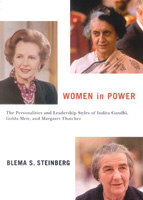Poli Psych 101
New book explores the impact of personalities in politics

Emeritus McGill professor Blema Steinberg delves deep into the minds of political leaders to uncover the psychodynamic explanations for their leadership behaviours.
"Is she going to drag this on until the end, until August, until the convention?" asked emeritus McGill professor Blema Steinberg. "It's hard to know. I think what she's feeling is frustrated, and angry, but she's not a quitter. Everything about this kind of personality suggests that while the ship may be sinking, she will still be standing on the gunwales."
Those with a mild addiction to CNN may have already guessed that the "she" in question is the junior U.S. Senator from New York and presidential hopeful Hillary Rodham Clinton.
Steinberg, author of the forthcoming Women in Power: The Personalities and Leadership Styles of Indira Gandhi, Golda Meir, and Margaret Thatcher, is a rare breed of expert: one who has merged the worlds of politics and psychology. It is, therefore, not a hunch, but rather a comprehensive personality assessment that leads her to conclude Clinton will not quit the race for the Democratic presidential nomination until she has "absolutely no choice."
Steinberg began teaching at McGill's Department of Political Science in 1961 with a well-developed expertise in international relations, but eventually she wanted to know more about the people who were in power – perhaps more than they knew about themselves. "I became very interested in decision-making and how decision-makers made decisions," she said, "and I decided that I wanted to look more at the psychodynamic explanations for leadership behaviour."
So by 1984, while pursuing a program in psychoanalysis at McGill, she began splitting her time between the University and private practice and developed the singular expertise she has today. "What that did," she explained, "is it infused the research I did in international politics with psychological concepts."
For example, Steinberg's first book, Shame and Humiliation: Presidential Decision Making on Vietnam (1996), chronicled how long-standing and very personal insecurities deeply held by both Presidents Lyndon Johnson and Richard Nixon were at least partly responsible for some of the greatest social and political disasters of modern times.
"Johnson's better instincts told him he shouldn't [escalate the conflict in Vietnam]," Steinberg said, "but he was really pushed by tremendous feelings of inadequacy. He had tremendous fears of appearing cowardly because as a kid he would run from any kind of fight. Underneath all that bravado was a very insecure individual."
As for Nixon, he felt the Vietnamese had launched an offensive in February of 1969, just a month after he took office, with the purpose of personally humiliating him. "He was furious at them. So as a way of sort of getting even and just venting his rage, you had the decision to escalate the conflict in Cambodia. It was a colossal mistake."
Steinberg's attention then turned to the personal aspects of women leaders in particular, which led to her most recent book, to be released at the end of April. In Women in Power, Steinberg uses available biographical data to get a personality snapshot of three of modern history's most prominent female political leaders. "What I was interested in looking at was their personality profiles," she said, "because I was interested in a secondary question, which is: 'how do those personality profiles impact on their leadership style?'"
Focus on women: "dominance" dominates
The answers to such a question ought to be telling, offering a window into the minds of politicians and a better understanding of why they do the things they do, act the way they act. But just how does one go about sketching solid lines between a leader's personality and their style?
Steinberg decided her methodology would draw on the work of a colleague in psychology who had taken the American Psychiatric Association's diagnostic manual of various kinds of psychiatric disorders and "normalized" them. They developed a series of categories to describe the normal person who might have some disorder traits, but at a level that is not problematic. "In other words, if you talk about narcissism at its extreme end, it is a personality disorder for which you may choose to see a psychotherapist, while at the healthy range it's being self-confident and reasonably assured."
The three female leaders were then categorized on the basis of 10 different personality traits that, at their extreme, are problematic mental illnesses. For each trait, every individual would be classified as "normal," "prominent," or "mildly dysfunctional." (Generally, people score prominently on two or three traits).
Those results are then crossed against five areas of behaviour reflecting leadership styles – expressive behaviour, interpersonal relationships, cognitive style (how they process information), self-image and mood/temperament – allowing the analyst to understand how different scores in personality traits might translate into specific leadership behaviours. A leader who scores in the normal range on the "dominance" personality trait, for example, would exhibit expressive behaviour that is assertive and strong-willed, while a leader who scores at the prominent level may get into the territory of being controlling and overbearing.
That dominant trait, it turned out, was particularly important to Steinberg's research, because all her subjects scored highest in that category (though not enough to make it to the level of mild dysfunction).
So how does a prominent dominant trait manifest itself in leadership style? "Individuals scoring high on this trait are tough and competitive," Steinberg said. "They are very controlling and, cognitively, what emerges is that they are inflexible in terms of their thinking. The implication of this kind of a trait is the view that one knows better than others. They pride themselves on being unsentimental and often it expresses itself in terms of being intimidating."
Only one mould?
Some of this may resonate with readers who have been bitten by the U.S. primary political bug. Another political leader who scores very high on the dominant personality trait is none other than Clinton.
So does that mean there is only one successful mould for female politicians? Steinberg feels it is difficult to draw any definitive conclusions since her sample was so small. "I do think that the notion that women speak in a different voice may well be true," she said, but conceded that "I don't think it applies to women leaders. Successful female leaders may be more dominant, and the reason these traits are more in evidence than in male leaders is that women have always had to prove themselves."
But make no mistake, these traits are innate – a woman without them seeking to fit this mould would have a hard time doing so. "It's not that they get a primer on how to be tough and controlling," Steinberg said. "It's because of the fact that in order to accomplish their political goals they need to be strong."
Clinton's similarities to the women in Steinberg's book, and the consequent insight one can glean with respect to the current U.S. campaign, don't end there.
"The other thing that was interesting about all three women in the book is that none of them ranked high on what we call the 'outgoing' trait," present in people characterized by being "sociable, open, and the kind of politicians that the attendant public takes an immediate liking to," Steinberg said. "And here I would contrast, for example, Barrack Obama with Hillary Clinton. Obama ranks high on the outgoing trait, as did Bill Clinton."
While the dominant trait leads in prominence for Hillary Clinton, "ambition is a close second," Steinberg said. "And Hillary is arrogant, an aspect of the ambitious personality trait." This highlights what could be useful instruction for any politician: if you don't curb your tendency to dominate, you may seem—or worse, become—verbally abusive or even derisive. Get too ambitious and you may become too arrogant.
Ambition is, in fact, a trait Clinton and Obama share, so he may also need to be aware of becoming too arrogant, Steinberg said. As well, the prominence of the outgoing trait in Obama's personality profile suggests he should be careful that his tendency to speak in inspiring generalities doesn't turn into habitual expressions of scattered thoughts and that his natural inclination to want to be well liked by all may lead to an inability to make unpopular decisions. "His associates, at that time, reminisced that when Obama was editor of the Harvard Law Review, he could never make up his mind," Steinberg said. "He would hear all sides and was very much like Bill, a consensus builder. This can be taken too far."
In marked contrast, "it's not Hillary's natural instinct to be a people person, and consensus-seeking is not her natural tendency," Steinberg said. "But she's highly intelligent, and she's not dysfunctional – so she does learn."
The great safeguard
And that is important. For all the prominence of Hillary's dominant streak or Obama's outgoing tendencies, they cannot be said to be near a dangerous level.
"The people who reach that level are people like Zimbabwe's Robert Mugabe. Their level of narcissism and ambition would be over the top, which explains why they will do anything to stay in power, including bankrupting their entire nation and starving their people. But you rarely find that truly dysfunctional individuals can be successful in a democratic system," Steinberg said.
"And that's the great safeguard."


